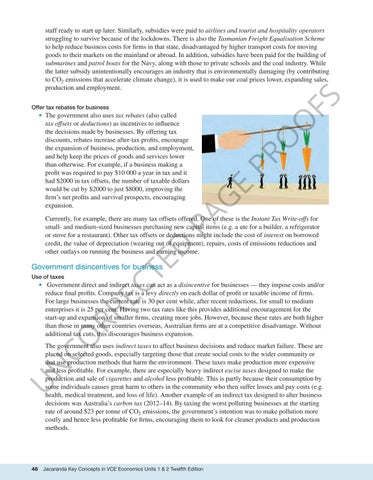“c01ThinkingLikeAnEconomist_PrintPDF” — 2022/7/18 — 23:09 — page 48 — #46
FS
staff ready to start up later. Similarly, subsidies were paid to airlines and tourist and hospitality operators struggling to survive because of the lockdowns. There is also the Tasmanian Freight Equalisation Scheme to help reduce business costs for firms in that state, disadvantaged by higher transport costs for moving goods to their markets on the mainland or abroad. In addition, subsidies have been paid for the building of submarines and patrol boats for the Navy, along with those to private schools and the coal industry. While the latter subsidy unintentionally encourages an industry that is environmentally damaging (by contributing to CO2 emissions that accelerate climate change), it is used to make our coal prices lower, expanding sales, production and employment.
O PR E G
PA
tax offsets or deductions) as incentives to influence the decisions made by businesses. By offering tax discounts, rebates increase after-tax profits, encourage the expansion of business, production, and employment, and help keep the prices of goods and services lower than otherwise. For example, if a business making a profit was required to pay $10 000 a year in tax and it had $2000 in tax offsets, the number of taxable dollars would be cut by $2000 to just $8000, improving the firm’s net profits and survival prospects, encouraging expansion.
O
Offer tax rebates for business • The government also uses tax rebates (also called
TE
D
Currently, for example, there are many tax offsets offered. One of these is the Instant Tax Write-offs for small- and medium-sized businesses purchasing new capital items (e.g. a ute for a builder, a refrigerator or stove for a restaurant). Other tax offsets or deductions might include the cost of interest on borrowed credit, the value of depreciation (wearing out of equipment), repairs, costs of emissions reductions and other outlays on running the business and earning income.
Government disincentives for business
CO RR EC
Use of taxes • Government direct and indirect taxes can act as a disincentive for businesses — they impose costs and/or
reduce final profits. Company tax is a levy directly on each dollar of profit or taxable income of firms. For large businesses the current rate is 30 per cent while, after recent reductions, for small to medium enterprises it is 25 per cent. Having two tax rates like this provides additional encouragement for the start-up and expansion of smaller firms, creating more jobs. However, because these rates are both higher than those in many other countries overseas, Australian firms are at a competitive disadvantage. Without additional tax cuts, this discourages business expansion.
U
N
The government also uses indirect taxes to affect business decisions and reduce market failure. These are placed on selected goods, especially targeting those that create social costs to the wider community or that use production methods that harm the environment. These taxes make production more expensive and less profitable. For example, there are especially heavy indirect excise taxes designed to make the production and sale of cigarettes and alcohol less profitable. This is partly because their consumption by some individuals causes great harm to others in the community who then suffer losses and pay costs (e.g. health, medical treatment, and loss of life). Another example of an indirect tax designed to alter business decisions was Australia’s carbon tax (2012–14). By taxing the worst polluting businesses at the starting rate of around $23 per tonne of CO2 emissions, the government’s intention was to make pollution more costly and hence less profitable for firms, encouraging them to look for cleaner products and production methods.
48
Jacaranda Key Concepts in VCE Economics Units 1 & 2 Twelfth Edition





















































